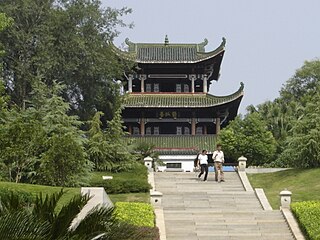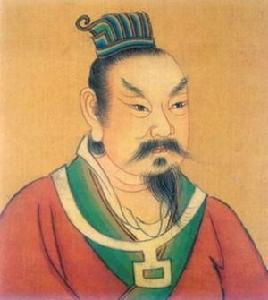Li Yantu (李彥圖) (died 913) was a ruler of Qian Prefecture (虔州, in modern Ganzhou, Jiangxi) from 912 to 913, early in the Chinese Five Dynasties and Ten Kingdoms period.

Ganzhou, formerly romanized as Kanchow, is a prefecture-level city in southern Jiangxi, China, bordering Fujian to the east, Guangdong to the south, and Hunan to the west. Its administrative seat is at Zhanggong District. Its population was 8,361,447 at the 2010 census whom 1,977,253 in the built-up area made of Zhanggong and Nankang, and Ganxian largely being urbanized.

Jiangxi is a province in the People's Republic of China, located in the southeast of the country. Spanning from the banks of the Yangtze river in the north into hillier areas in the south and east, it shares a border with Anhui to the north, Zhejiang to the northeast, Fujian to the east, Guangdong to the south, Hunan to the west, and Hubei to the northwest.

The earliest known written records of the history of China date from as early as 1250 BC, from the Shang dynasty, during the king Wu Ding's reign, who was recorded as the twenty-first Shang king by the written records of Shang dynasty unearthed. Ancient historical texts such as the Records of the Grand Historian and the Bamboo Annals describe a Xia dynasty before the Shang, but no writing is known from the period, and Shang writings do not indicate the existence of the Xia. The Shang ruled in the Yellow River valley, which is commonly held to be the cradle of Chinese civilization. However, Neolithic civilizations originated at various cultural centers along both the Yellow River and Yangtze River. These Yellow River and Yangtze civilizations arose millennia before the Shang. With thousands of years of continuous history, China is one of the world's oldest civilizations, and is regarded as one of the cradles of civilization.
Nearly nothing is known about Li Yantu's personal background, including where or when he was born. In 912, when Li Qiu, who had seized control of Qian Prefecture after assassinating the prior ruler Lu Yanchang and subsequently was given the title of defender of Qian by Zhu Wen, died, Li Yantu took over by himself and apparently took the title of defender of Qian as well. (It is not clear from the extant historical records whether he received official sanction from Later Liang and/or its rival Wu, to whom Lu had previously submitted.) After Li Yantu's seizure of power, the senior officer Tan Quanbo, a long-time strategist for Lu Yanchang's father Lu Guangchou, whom Li Qiu had considered killing, claimed to be seriously ill and retired from military service. Upon hearing of Tan's illness, Liu Yan the military governor of Qinghai Circuit (清海, headquartered in modern Guangzhou, Guangdong), nominally a Later Liang vassal, attacked Shao Prefecture (韶州, in modern Shaoguan, Guangdong), which had been part of the domain of the Qian Prefecture rulers since Lu Guangchou's time. Liao Shuang (廖爽) the prefect of Shao, whom Lu Yanchang had commissioned, abandoned Shao and fled to Chu, ending Qian rulers' control of Shao. [1]
Li Qiu (黎球) was an army officer who ruled Qian Prefecture briefly after assassinating the previously ruler Lu Yanchang in 911, early in the Chinese Five Dynasties and Ten Kingdoms period. He died shortly after taking over Lu's position.
Lu Yanchang (盧延昌) was a ruler of the Qian Prefecture region early in the Chinese Five Dynasties and Ten Kingdoms period. He inherited his position from his father Lu Guangchou, who had ruled the region for 25 years, but himself ruled only from 910 to 911 before being assassinated and succeeded by his officer Li Qiu.

Emperor Taizu of Later Liang (後梁太祖), personal name Zhu Quanzhong (朱全忠) (852–912), né Zhu Wen (朱溫), name later changed to Zhu Huang (朱晃), nickname Zhu San, was a Jiedushi and warlord who in 907 overthrew the Tang dynasty and established the Later Liang as its emperor, ushering in the era of the Five Dynasties and Ten Kingdoms. The last two Tang emperors, Emperor Zhaozong of Tang and Emperor Ai of Tang, who "ruled" as his puppets from 903 to 907, were both murdered by him.
In 913, Li Yantu died. The people of the prefecture supported Tan to succeed him. [1]

Qian Liu, known as Qian Poliu during his childhood, was a warlord of the late Tang dynasty who founded the Wuyue kingdom.
Liu Yan, né Liu Yan (劉巖), also known as Liu Zhi (劉陟) and briefly as Liu Gong (劉龔), formally Tianhuang Dadi (天皇大帝) with the temple name Gaozu (高祖), was the first emperor of the Chinese Five Dynasties and Ten Kingdoms period state Southern Han.
Ma Yin, courtesy name Batu (霸圖), formally King Wumu of Chu (楚武穆王), was a warlord late in the Chinese dynasty Tang Dynasty who became the first ruler of the Five Dynasties and Ten Kingdoms Period state Chu and the only one who carried the title of "king." He initially took control of the Changsha region in 896 after the death of his predecessor Liu Jianfeng, and subsequently increased his territorial hold to roughly modern Hunan and northeastern Guangxi, which became the territory of Chu.
Liu Yin (劉隱), formally Prince Xiang of Nanhai (南海襄王), later further posthumously honored Emperor Xiang (襄皇帝) with the temple name of Liezong (烈宗) by his younger brother Liu Yan, was a warlord late in the Chinese dynasty Tang Dynasty and Tang's succeeding dynasty Later Liang of the Five Dynasties and Ten Kingdoms period, who ruled Qinghai Circuit as its military governor (Jiedushi). It was on the basis of his rule that Liu Yan was later able to establish the state of Southern Han.
Du Hong (杜洪) was a warlord late in the Chinese dynasty Tang Dynasty, who controlled Wuchang Circuit from 886 to 905. In 905, he was defeated and captured by Yang Xingmi, who executed him.
Lu Guangchou (盧光稠) was a warlord late in the Chinese dynasty Tang Dynasty and who nominally submitted to both the succeeding Later Liang and Later Liang's rival Wu after the end of Tang, who controlled the Qian Prefecture region from 885 to his death in 910.
Tan Quanbo (譚全播) (834?-918?) was a ruler of Qian Prefecture from 913 to 918, early in the Chinese Five Dynasties and Ten Kingdoms period. He was a long-time strategist of Lu Guangchou, who ruled Qian Prefecture for 25 years, and after several transitional rulers after Lu's death was supported by the people to govern the prefecture. In 918, he was defeated by Wu forces, which took over Qian. He died shortly after.
Tian Jun, courtesy name Dechen (德臣), was a warlord late in the Chinese Tang Dynasty, who ruled Ningguo Circuit at its military governor (Jiedushi) from 892 to his death in 903. He was a childhood friend of the major warlord Yang Xingmi the military governor of Huainan Circuit, served under Yang during various campaigns, and continued to be Yang's vassal after he became a military governor. However, he eventually became angry at Yang's refusal to support him in his own campaigns of expansion. In 903, he rebelled against Yang in conjunction with An Renyi (安仁義) the military prefect of Run Prefecture and, for some time, posed a major threat to Yang's continued rule of Huainan, but was soon defeated by Yang's officer Tai Meng (臺濛) and killed in battle.
Li Cunshen (李存審), né Fu Cun (符存), often referred to in historical sources as Fu Cunshen (符存審), courtesy name Dexiang (德詳), was a major general of the Chinese Five Dynasties and Ten Kingdoms period dynasty Later Tang and Later Tang's predecessor state Jin. He was an adoptive son of Jin's first prince Li Keyong and later served in a number of major campaigns under the reign of Li Keyong's son Li Cunxu, helping Li Cunxu to establish Later Tang as its Emperor Zhuangzong.
Xu Wen (徐溫), courtesy name Dunmei (敦美), formally Prince Zhongwu of Qi (齊忠武王), later further posthumously honored Emperor Wu (武皇帝) with the temple name Yizu (義祖) by his adoptive son Xu Zhigao after Xu Zhigao founded the state of Southern Tang, was a major general and regent of the Chinese Five Dynasties and Ten Kingdoms period state Wu. He took over the reins of the Wu state after assassinating, with his colleague Zhang Hao, Yang Wo, the first Prince of Hongnong, and then killing Zhang. Xu was in essence the decision-maker throughout the reign of Yang Wo's brother and successor Yang Longyan and the first part of the reign of Yang Longyan's brother and successor Yang Pu. After his death, Xu Zhigao inherited his position as regent, eventually seizing the Wu throne and establishing Southern Tang.
Liu Xun (劉鄩) was a major general of the Chinese Five Dynasties and Ten Kingdoms period state Later Liang. He was a key commander of Later Liang forces in its struggle with its archenemy Jin, but, after repeated defeats by the Jin prince Li Cunxu, Liu sought retirement, and was subsequently poisoned to death by the Later Liang emperor Zhu Zhen, who doubted his loyalty.
Wang Jingren (王景仁), né Wang Maozhang, was a major general during the Chinese Five Dynasties and Ten Kingdoms period state Later Liang. He was originally a general under Yang Xingmi the Prince of Wu in the late Tang Dynasty, but later got into a dispute with Yang's son and successor Yang Wo and forced to flee to the domain of Qian Liu, who, as a Later Liang vassal, later sent Wang to Later Liang, whose Emperor Taizu was impressed with Wang's abilities and therefore made Wang a major general. Wang, however, was not successful in subsequent campaigns against either Wu or Later Liang's northern enemy Jin.
Li Shenfu (李神福) was a general who served under the major warlord Yang Xingmi the military governor (Jiedushi) of Huainan Circuit late in the Chinese dynasty Tang Dynasty.
Yan Keqiu (嚴可求) was a key official of the Chinese Five Dynasties and Ten Kingdoms period state Wu, as the chief strategist for the Wu regent Xu Wen and each of Wu's three rulers, Yang Wo, Yang Longyan, and Yang Pu.
Dai Siyuan (戴思遠) was a general of the Chinese Five Dynasties and Ten Kingdoms period state Later Liang, serving for several years as the supreme commander of the Later Liang forces against its archrival Jin. After Later Tang conquered Later Liang, Dai continued to serve Later Tang until his death.
Qian Yuanguan (錢元瓘), born Qian Chuanguan (錢傳瓘), formally King Wenmu of Wuyue (吳越文穆王), courtesy name Mingbao (明寶), was the second king of the state of Wuyue, during the Five Dynasties and Ten Kingdoms period of China. During his reign, his kingdom was centred on modern Zhejiang. He ascended to the throne in 932, when his father Qian Liu left the state in his hands, to 941. He was the father to all three of Wuyue's subsequent kings.
Yang Dongqian (楊洞潛), courtesy name Zhaoxuan (昭玄), was an official of the Chinese Five Dynasties and Ten Kingdoms period state Southern Han, serving as a chancellor.
Yao Yanzhang was a key general serving under Ma Yin, a warlord of the late Chinese Tang Dynasty and the founder of the Five Dynasties and Ten Kingdoms Period state Chu.




